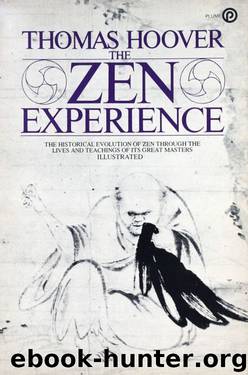The Zen Experience by Thomas Hoover

Author:Thomas Hoover [Hoover, Thomas]
Language: eng
Format: epub
Tags: zen buddhism zen history sengchao, hungjen, yunmen, taosheng bodhidharma huiko, matsu, hanshan huangpo, huaihai nanchuan chaochou pang, taosheng, tahui, fajung, soto, linchi rinzai, hui neng, eisai dogen, lao tzu chuang tzu kuo hsiang nagarjuna sengchao, tungshan tsaoshan kueishan, zen history buddhism, shenhsiu, sengtsan taohsin, hakuin
Publisher: Thomas Hoover
Published: 0101-01-01T00:00:00+00:00
Chapter Twelve
*
TUNG-SHAN AND TS’AO-SHAN: FOUNDERS OF SOTO ZEN
*
Tung-shan
*
Virtually all the masters encountered up to this point have been traceable to Ma-tsu, descendant in Dharma of the legendary Huai-jang and his master, the Sixth Patriarch, Hui-neng. This was the line that became Japanese Rinzai Zen, many centuries later. However, Hui-neng had another follower, a shadowy figure remembered as Ch'ing-yuan Hsing-ssu (d. 740) whose line also was perpetuated to present-day Japan.1 His foremost pupil was Shih-t'ou (700-90), and a common description of the eighth-cen- tury Ch'an establishment was: "In Kiangsi the master was Ma-tsu; in Hunan the master was Shih-t'ou. People went back and forth between them all the time, and those who never met these two great masters were completely ignorant."2 Shih-t'ou jousted with Ma-tsu, and they often swapped students. Ma-tsu sent his pupils on their way with a wink and the advice that Shih-t'ou was "slippery."3 This legendary master was forebear of three of the five "houses" of Ch'an arising after the Great Persecution of 845, although the only one of the three surviving is the Ts'ao-tung, which arose during the later T'ang (618-907) and early Five Dynasties (907-960) period and remains today as Japanese Soto.
One of the cofounders of the Ts'ao-tung house was known as Tung-shan Liang-chieh (807-869), who was born in present day Chekiang but eventually found his way to what is now northern Kiangsi province.4 As did most great masters, he took Buddhist orders early, and one of the most enduring stories of his life has him confounding his elders—an event common to many spiritual biographies. He began as a novice in the Vinaya sect, an organization often more concerned with the letter of the law than its spirit. One day he was asked to recite the Heart Sutra, but when he came to the phrase "There is no eye, ear, nose, tongue, body, or mind," he wonderingly touched his own face and then inquired of his master, "I have eyes, ears, nose, tongue, and so forth; how, then, can the sutra say there are no such things?"5 The Vinaya master was dumbfounded by his iconoclasm and suggested that his bent of mind would be more readily cultivated in the Ch'an sect. So off he went to Mt. Sung, where he subsequently was ordained at the precocious age of twenty-one.
Afterward he traveled across China, typical for young monks of the age. Ironically enough, considering that his line eventually rivaled Ma-tsu's, his first stop was the monastery of Nan-ch'uan, one of the foremost disciples of Ma-tsu. As he arrived, Nan-ch'uan was announcing a memorial service to be conducted the next day on the anniversary of his master's death, a standard Chinese custom.
*
Nan-ch'uan remarked, "When we serve food for Master Ma-tsu tomorrow, I do wonder whether he will come for it." None of the monks made a reply but [Tung-shan] came forth out of the crowd and said, "As soon as he has companions he will come." Hearing this, Nan-ch'uan praised him: "Although this man is young, he is worthy of being trained.
Download
This site does not store any files on its server. We only index and link to content provided by other sites. Please contact the content providers to delete copyright contents if any and email us, we'll remove relevant links or contents immediately.
| Philosophy | Spirituality |
The Way of Zen by Alan W. Watts(6548)
Ego Is the Enemy by Ryan Holiday(5347)
The Art of Happiness by The Dalai Lama(4090)
The Book of Joy by Dalai Lama(3944)
Why Buddhism is True by Robert Wright(3423)
Spark Joy by Marie Kondo(3270)
Shift into Freedom by Loch Kelly(3164)
Happiness by Matthieu Ricard(3020)
A Monk's Guide to a Clean House and Mind by Shoukei Matsumoto(2891)
The Lost Art of Good Conversation by Sakyong Mipham(2629)
The Meaning of the Library by unknow(2533)
The Unfettered Mind: Writings from a Zen Master to a Master Swordsman by Takuan Soho(2272)
The Third Eye by T. Lobsang Rampa(2242)
Anthology by T J(2181)
Red Shambhala by Andrei Znamenski(2167)
The Diamond Cutter by Geshe Michael Roach(2036)
Thoughts Without A Thinker: Psychotherapy from a Buddhist Perspective by Epstein Mark(1986)
Twilight of Idols and Anti-Christ by Friedrich Nietzsche(1870)
Advice Not Given by Mark Epstein(1857)
